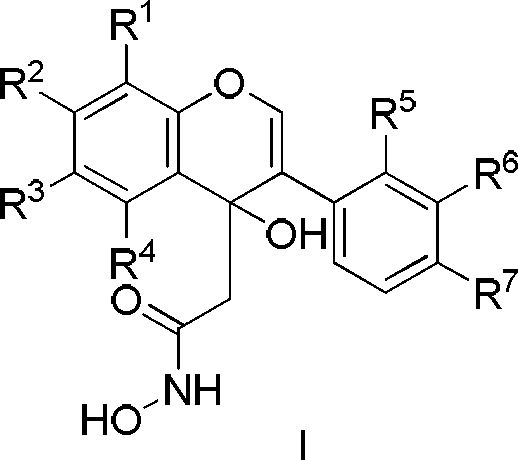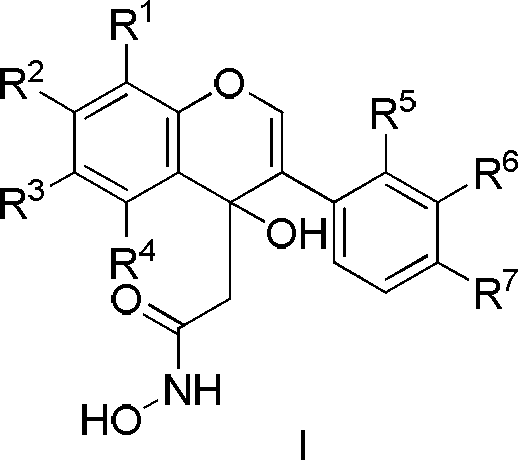Urease inhibitor genistein hydroxamic acid compound and synthesis and application thereof
A technology of isoflavone hydroxamic acid and isoflavone hydroxamic acid, which is applied in the field of isoflavone hydroxamic acid compounds, can solve the problems of low activity, hindering application, and large dosage
- Summary
- Abstract
- Description
- Claims
- Application Information
AI Technical Summary
Problems solved by technology
Method used
Image
Examples
Embodiment 1
[0030] Example 1: Preparation of 2-(3-(3-aminophenyl)-4,5,7-trihydroxy-4H-benzopyran-4-yl)acetylhydroxamic acid (54) with 1,3 , Dissolve 1.2001g (7.9mmol) of 5-trihydroxyphenol in 15mL of anhydrous ether, add 1.1471g (8.7mmol) of 3-aminophenylacetonitrile and 0.2138g (1.6mmol) of newly molten zinc chloride, and pass through to dry HCl gas, stirred in an ice bath for 12 hours, after removing ether, added 30 mL of deionized water, stirred, adjusted the pH to 3-5, hydrolyzed at 80°C for 1.5 hours, filtered after cooling, washed with water, dried, and purified by silica gel column chromatography. Eluent volume ratio: AcOEt:petroleum ether=1:5, to obtain 1.7596g (6.8mmol) of 1-(2,4,6-trihydroxyphenyl)-2-m-aminophenylethanone;
[0031] At room temperature, 3.1 mL (25.2 mmol) of BF 3 ·Et 2 O was dropped into 25 mL of anhydrous DMF containing 1.7596 g (6.8 mmol) of 1-(2,4,6-trihydroxyphenyl)-2-m-aminoacetophenone, stirred for 10 minutes, and then CH 3 SO 2 Cl2.8808g (25.2mmol), 80...
Embodiment 2
[0035] The isoflavone hydroxamic acid series compounds 1-76 listed in Table 1 were synthesized in the same manner as in Example 1, using different substituted benzaldehydes as raw materials.
[0036] Each R group of isoflavone hydroxamic acid series compounds in the general formula I of table 1
[0037] serial number
[0038] 27
[0039] 55
[0040] Note: The initial raw materials were purchased from aldrich company
Embodiment 3
[0041] Embodiment 3: the inhibitory enzyme activity of compound
[0042] Add 25 μL of Jack bean urease (4U) and 25 μL (1 mM) of the test compound solution to the 96-well plate, incubate at 37 °C for 2 h, then add 55 μL of phosphate buffer containing 100 mM urea and 100 mM, and incubate at 30 °C. Incubate at ℃ for 15 min, add 45 μL of phenol reagent (mixed solution containing 1% phenol and 0.005% sodium nitroprusside) and 70 μL alkali reagent (mixed solution of NaOCl containing 0.5% NaOH and 0.1% active chlorine), at room temperature After standing for 50 minutes, measure the OD value at 630nm with a microplate reader, and the percentage inhibition rate is calculated according to the following formula:
[0043]
[0044] All experiments were performed in solutions at pH 8.2 (0.01M K 2 HPO 4 , 1mM EDTA, 0.01M LiCl), the level of activity is measured by the half-inhibition rate IC 50 to indicate that the IC 50 The smaller the value, the higher the activity of the compound. ...
PUM
 Login to View More
Login to View More Abstract
Description
Claims
Application Information
 Login to View More
Login to View More - R&D
- Intellectual Property
- Life Sciences
- Materials
- Tech Scout
- Unparalleled Data Quality
- Higher Quality Content
- 60% Fewer Hallucinations
Browse by: Latest US Patents, China's latest patents, Technical Efficacy Thesaurus, Application Domain, Technology Topic, Popular Technical Reports.
© 2025 PatSnap. All rights reserved.Legal|Privacy policy|Modern Slavery Act Transparency Statement|Sitemap|About US| Contact US: help@patsnap.com



